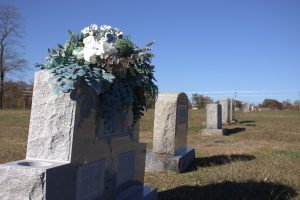At a Durham City Council meeting, you can expect to see a diversity of ethnicities, genders, religions, and opinions in the audience. Monday night’s meeting also included a diversity of species. Hand-painted blue birds, raised on wooden sticks, sat interspersed among the audience members, making a special guest appearance.
The birds in question? Artistic representations of the 160 great blue herons and great egrets who have built a home in northeast Durham. In the halls of City Council, on the first night of May, the birds’ future was decided.
In a 4-2 vote, the council voted to assign 215 acres of city-owned property to a dedicated nature preserve, ensuring permanent protection by the state of North Carolina.
The Ellerbe Creek Watershed Association, a nonprofit environmental organization based in Durham, proposed the measure, along with the North Carolina Department of Natural and Cultural Resources. The two groups have pushed to protect this city-owned parcel of land, one of the few sites in North Carolina’s Piedmont region where great blue herons and great egrets nest.
During the meeting, five passionate advocates took the stand to argue for permanent protection, and four joined via Zoom. Passion for this cause extended beyond the podium. Throughout the evening, as the audience waved their illustrations of the great blue herons mounted on wooden sticks, council members described being inundated with emails calling for a dedicated nature preserve for the rookery.
“We need all of these plants, we need all of the wildlife, we need all biodiversity to continue to live,” Durham resident Bonita Green said over Zoom. “It needs to be dedicated as a state nature preserve so that we can preserve this wildlife for the animals, as well as for humans for our physical and mental health.”
Council members were united on the importance of the land’s preservation. “The question is not whether or not we should protect it — but how?” said Mayor Pro Tem Mark Anthony Middleton.
Throughout the meeting, environmental jargon flew through the air, representing a fundamental conflict. City staffers proposed the creation of a city-controlled registered heritage area to protect the rookery, while the environmentalists proposed a Dedicated Nature Preserve through the state Natural Heritage Program. Both dedicated nature preserves and registered heritage areas advance conservation efforts and protect regional biodiversity. David Fleischer, a city general services department representative, said a dedicated nature preserve designation cannot be undone.
“It is truly permanent and perpetual. The only instance in which it could be undone is an act of the governor and the Council of State,” he said.
Council member DeDreana Freeman advocated for the designated nature preserve throughout the meeting.
“This council has been responsible for building in a wetland numerous times,” she said. “So… the permanency of having state protections in place feels like we’re working towards climate resilience and not against it….”
Some notable designated nature preserves in North Carolina include Eno River State Park and Jordan Lake game lands. Contrastingly, a registered heritage area can be undone at any point by the City Council. Some local registered heritage areas include Duke Forest and Bennett Place Forest.
Proponents of the Ellerbe Creek proposal urged the council to pursue state protection.
“There is protection and there is permanent protection,” said local resident Dave Connolly. “The staff’s recommendation is reasonable and should be good enough for today, but might not necessarily protect the egret sanctuary for the future.”
Ricky White, executive director of the Ellerbe Creek Watershed Association, said more funding is available to dedicated sites than registered sites. He also attempted to ease concerns regarding state involvement. Permanent protection “doesn’t mean that the state can then do random things to the property. It just means that the state can monitor the activities of the property, and if it’s not being conserved, then they can act legally to enforce that,” he said.
In order to accommodate infrastructure concerns, the proposal was amended prior to the meeting to allow for an 800-foot- wide carve-out for future parkway construction. During Monday night’s discussion, council member Jillian Johnson raised other questions regarding the impact of the new designation on future Durham development. In response to questioning by Johnson, Fleischer noted that the vast majority of the area in question is not developable because it sits on a floodplain. Of the 215 proposed acres, only “a small, about 30-acre section” could potentially be developed, he said.
Council members Johnson and Middleton voted no on the proposed motion.
“I think we’re all committed to preserving this land — there’s no controversy there,” Middleton said. “But I can’t support this motion tonight. I think there are too many unanswered questions…. We can achieve protecting this land, and the birds, without moving with lightning speed tonight.”
In the end, the motion moved forward and the council reached what Mayor Elaine O’Neal described as “step one” of a long process of ensuring protection for the city’s winged residents.
Above: Images of great blue herons and great egrets at their rookery in northeast Durham, from a video posted by the Ellerbe Creek Watershed Association. Video by D.L. Anderson.









